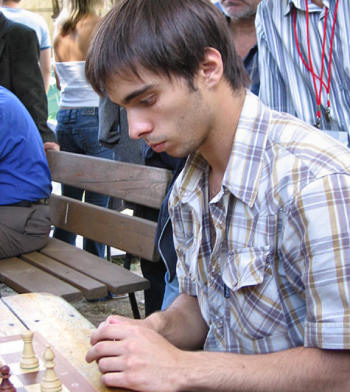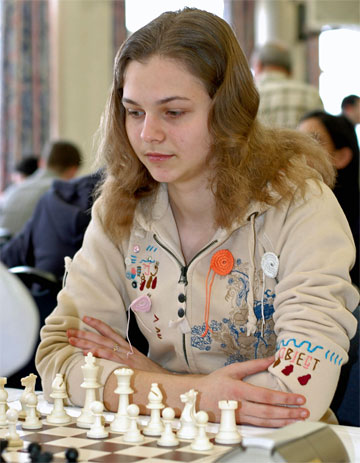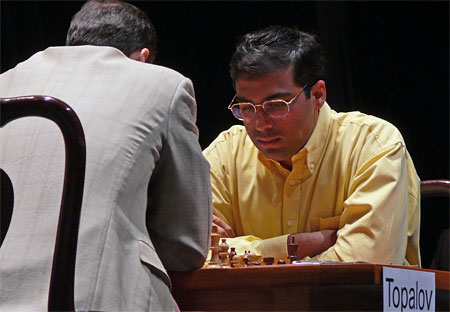| Latest | Greatest | Lobby | Journals | Search | Options | Help | Login |
|
|
|
This topic is archived. |
| Home » Discuss » Topic Forums » Sports |
|
| Jack Rabbit
|
Sun Feb-17-08 04:29 PM Original message |
| The Jack Rabbit Chess Report (February 17): 3 Major Tournaments Begin |
|
Morelian-Linares Opens in Mexico
The 25th annual super grandmaster tournament began Friday in Morelia, Michoac�n (Mexico). This year�s participants are world champion Vishy Anand of India Aremenia�s Levon Aronian; seventeen-year-old Norwegian grandmaster Magnus Carlsen; Vassily Ivanchuk of Ukraine; Hungarian GM Peter Leko; Azerbaijan�s Teimour Radjabov; the Latvian-Spanish grandmaster Alexey Shirov; and the former FIDE world champion, Veselin Topalov of Bulgaria. The event is a double-round robin. The first Robin will be played in Mexico, concluding Saturday, then the players take a five-day break and resume in Linares, Andaluc�a (Spain) beginning February Thursday, 28 running through March 7. The English language version of the official website for the Mexican half of the event is here. One can click on Live Games in the upper left hand corner of the page to follow the action beginning at 3 pm CST today, Tuesday, Wednesday, Friday and Saturday. After two rounds, Ivanchuk and Topalov lead with a point and a half each. Aeroflot Open Begins The Aeroflot Open, one of the best of the annual Swiss system events on the calendar, began Thursday in Moscow, where another great Swiss system tournament, the Moscow Open, finished last week. The fourth round was played today. Tied for the lead are two seventeen-year-old GMs, Ian Napomniachtchi of Russia and Israel�s Maxim Rodshtein, and Boris Grachev, 22, of Russia, with 3� points apiece. Seven players are tied with 3 points each, including the recent champion of the Moscow Open, Russia�s Artyom Timofeev. The nine-round event concludes Friday. Open Tournament Underway in Chapelle la Grande The annual open tournament in Chapelle la Grande began yesterday in France. The biggest upset in yesterday�s first round saw young international master Jon Ludwig Hammer of Norway defeat Greek GM Vasilios Kotronias. The event concludes Saturday. |
| Printer Friendly | Permalink | | Top |
| Jack Rabbit
|
Sun Feb-17-08 04:29 PM Response to Original message |
| 1. Games from the Moscow Open |
|
Diagrams on the Jack Rabbit Chess Report are made with Chess M�rida, a true type font that can be downlaoded free here. |
| Printer Friendly | Permalink | | Top |
| Jack Rabbit
|
Sun Feb-17-08 04:30 PM Response to Reply #1 |
| 2. J. Geller - Raizantsev, Round 3 |
|
Edited on Sun Feb-17-08 04:38 PM by Jack Rabbit
 Alexander Riazantsev Jakov Geller - Alexander Riazantsev Moscow Open, Group A, Round 3 Moscow, 4 February 2008 East India Game: Queen's Indian Defense 1.c4 e6 2.Nc3 d5 3.d4 Be7 4.Nf3 Nf6 5.e3 0-0 6.Bd3 b6 7.0-0 Bb7 8.cxd5
8...exd5 9.b3 Nbd7 10.Bb2 a6
11.Rc1 Bd6 12.Qc2 Qe7 13.Ne2 Rac8!?
14.Bf5 g6 15.Bd3
15...Ne4
16.Bxe4?
!""""""""# $ +t+ Tl+% $+vOmWo+o% $oO V +o+% $+ +o+ + % $ + Pb+ +% $+p+ Pn+ % $pBq+nPpP% $+ R +rK % /(((((((() WHITE: Jakov Geller Position after 16.Bd3e4:N 16...dxe4!
17.Nd2 b5
18.Rfd1 c5
19.Qb1 cxd4
20.Rxc8
20...Rxc8 21.Bxd4 Nc5 22.Qa1!
22...Nd3!
23.Nf1 Rc2 24.Bf6
24...Qc7 25.Nfg3
25...Bxg3 26.Nxg3 Rxf2 27.Qd4
!""""""""# $ + + +l+% $+bW +o+o% $o+ + Bo+% $+O+ + + % $ + Qo+ +% $+p+mP N % $p+ + TpP% $+ +r+ K % /(((((((() WHITE: Jakov Geller Position after 27.Qa1d4 27...Rxg2+!!
28.Kxg2 Qc2+ 29.Kg1 Qxd1+ 30.Nf1 Qg4+
31.Ng3 Qd1+
32.Nf1
32...Qg4+ 33.Ng3 Qc8 34.Bh8 Qf8
35.Bf6
35...Nc5 36.Kf2 Qc8 37.h4 h5 38.b4
38...Nd3+ 39.Kg1 Kh7 40.Qd6
40...Qc1+ 41.Nf1 Qe1 42.Qd8
42...Qf2+
43.Kh1 Qxf1+ 44.Kh2 Qe2+ 45.Kh1 Qd1+ 46.Kh2 Qd2+ 0-1
|
| Printer Friendly | Permalink | | Top |
| Jack Rabbit
|
Sun Feb-17-08 04:40 PM Response to Reply #1 |
| 4. Tiviakov - Le, Round 6 |
 Le Quang Liem Sergei Tiviakov - Le Quang Liem Moscow Open, Group A, Round 6 Moscow, 7 February 2008 C;osed Sicilian Game: Saragossa Opening (Alapin Attack) 1.e4 c5 2.c3 Nf6
3.e5 Nd5 4.g3
4...d6 5.exd6 e6 6.Bg2 Bxd6 7.Nf3 0-0 8.d4 Nc6 9.dxc5!?
9...Bxc5 10.0-0 b5
11.b4 Bd6 12.a4 bxa4 13.Rxa4 Bb7 14.Ng5
14...Be7 15.Qh5?!
15...h6!
16.Ne4 Qc7 17.Re1 Rad8?
18.Nc5!
18...Ba8!?
!""""""""# $v+ T Tl+% $O W VoO % $ +m+o+ O% $+ Nm+ +q% $rP + + +% $+ P + P % $ + + PbP% $+nB R K % /(((((((() WHITE: Sergei Tiviakov Position after 18...Bb7a8 19.Bxh6!
19...Nf6!?
20.Qh3?
20...gxh6 21.Qxh6 !""""""""# $v+ T Tl+% $O W Vo+ % $ +m+oM Q% $+ N + + % $rP + + +% $+ P + P % $ + + PbP% $+n+ R K % /(((((((() WHITE: Sergei Tiviakov Position after 21.Qh3h6:p 21...Ng4!!
22.Nxe6 Qe5!
23.Qc1
23...Qh8 24.h3 fxe6 25.Rxe6
25...Rxf2 26.Rg6+ Kf7 27.Rxg4 Rxg2+ 28.Kf1 Ke8 0-1
|
| Printer Friendly | Permalink | | Top |
| Jack Rabbit
|
Sun Feb-17-08 04:42 PM Response to Reply #1 |
| 5. Efimenko - Smirnov, Round 9 |
|
Edited on Sun Feb-17-08 04:43 PM by Jack Rabbit
 Zahar Efimenko Zahar Efimenko - Pavel Smirnov Moscow Open, Group A. Round 9 Moscow, 10 February 2008 Closed Sicilian Game: Boleslavsky Defense 1.e4 c5 2.Nf3 Nc6 3.Nc3 e5 4.Bc4 Be7 5.d3 d6 6.0-0
6...Nf6 7.h3
7...0-0 8.a3 Nd4
9.Nd5!?
9...h6
10.c3?!
10...Nxf3+ 11.Qxf3 Be6?
12.Nxf6+!
12...Bxf6 13.Bxe6 fxe6 !""""""""# $t+ W Tl+% $Oo+ + O % $ + OoV O% $+ O O + % $ + +p+ +% $P Pp+q+p% $ P + Pp+% $R B +rK % /(((((((() WHITE: Zahar Efimenko Position after 13...fe6:B 14.Qg4!!
14...Kf7
15.f4 Ke7
16.fxe5 Bxe5 17.Be3 Qb6 18.b4 Bxc3
19.d4 g5
20.dxc5 Qa6
21.cxd6+ Kd7
22.Rad1
22...Qxa3
23.Qh5 Rxf1+ 24.Rxf1 Qxb4
!""""""""# $t+ + + +% $Oo+l+ + % $ + Po+ O% $+ + + Oq% $ W +p+ +% $+ V B +p% $ + + +p+% $+ + +rK % /(((((((() WHITE: Zahar Efimenko Position after 24...Qa3b4:p 25.Qf7+!
25...Kxd6 26.Rd1+ Ke5 27.Bf2 Bd2 28.Bg3+ Bf4 29.Qg7+ Kxe4 30.Qg6+ Ke5 31.Re1+ Qxe1+
32.Bxe1 1-0 |
| Printer Friendly | Permalink | | Top |
| Jack Rabbit
|
Sun Feb-17-08 04:44 PM Response to Reply #1 |
| 6. From the Tournament Champions . . . |
| Printer Friendly | Permalink | | Top |
| Jack Rabbit
|
Sun Feb-17-08 04:46 PM Response to Reply #6 |
| 7. Timofeev - Efimenko, Round 7 |
 Artyom Timofeev Artyom Timofeev - Zahar Efimenko Moscow Open, Group A, Round 7 Moscow, 8 February 2008 Open Sicilian Game: Najdorf-Boleslavsky Defense 1.e4 c5 2.Nf3 d6 3.d4 cxd4 4.Nxd4 Nf6 5.Nc3 a6 6.Be3 e5 7.Nf3
7...Be7 8.Bc4 0-0 9.0-0 Nc6
10.Re1
10...b5 11.Bf1 Rb8 12.Bg5 Ng4 13.Bc1
13...Qb6 14.Qd2 Nf6 15.Nd5!?
15...Nxd5 16.exd5 Na5 17.a4
17...Nc4?
!""""""""# $ Tv+ Tl+% $+ + VoOo% $oW O + +% $+o+pO + % $p+m+ + +% $+ + +n+ % $ PpQ PpP% $R B RbK % /(((((((() WHITE: Artyom Timofeev Position after 17...Na5c4 18.Qb4!
18...Qb7
19.a5
19...Bf6 20.Bg5!
20...Bxg5 21.Nxg5 Qxd5 22.Red1
22...Qc6
23.b3 Bg4 !""""""""# $ T + Tl+% $+ + +oOo% $o+wO + +% $Po+ O N % $ Qm+ +v+% $+p+ + + % $ +p+ PpP% $R +r+bK % /(((((((() WHITE: Artyom Timofeev Position after 23...Bf8g4 24.bxc4!!
24...Bxd1 25.Rxd1 bxc4
26.Qxc4 Qxc4 27.Bxc4 Rb4 28.Bb3 h6
29.Nf3 Rc8 30.g3 Rc6
31.Nh4 Rd4 32.Ra1 Rb4 33.Nf5 Kf8
34.Rd1 g6
35.Rxd6 Rxd6 36.Nxd6 f5
37.Bd5 Ke7 38.Nb7 Kd7
39.c4 Kc7 40.Nc5 Kd6 41.Nxa6 Ra4
42.Kf1 Rxa5 43.Bb7 1-0
|
| Printer Friendly | Permalink | | Top |
| Jack Rabbit
|
Sun Feb-17-08 04:53 PM Response to Reply #6 |
| 8. Girya - Muzychuk, Round 8 |
 Anna Muzychuk Moscow Open, Ladies' Competition, Round 8 Moscow, 9 February 2008 Scandanavian Game: Horseman Gambit 1.e4 d5 2.exd5 Nf6
3.Bb5+
3...Bd7 4.Bc4
4...Bg4 5.f3 Bc8
6.Nc3 Nbd7 7.Nge2
7...Nb6 8.Bb3 a5!?
9.a3 a4 10.Ba2 Nbxd5 11.d4
11...e6 12.0-0 Be7 13.Ne4
13...b5 14.Nf4!?
14...Bb7
15.Qd3
15...0-0 16.Bd2 Nxf4!?
17.Bxf4 Bd5
18.Bxd5 Nxd5 19.Bg3
19...Qd7 20.Rad1 Nb6
21.Qc3
21...Nd5 22.Qe1
22...Qc6 23.Qe2?
23...Nb6 24.Nc3
!""""""""# $t+ + Tl+% $+ O VoOo% $ Mw+o+ +% $+o+ + + % $o+ P + +% $P N +pB % $ Pp+q+pP% $+ +r+rK % /(((((((() WHITE: Olga Girya Position after 24.Ne4c3 24...Bxa3!!
25.bxa3 Qxc3 26.Qxb5
26...Qxa3 27.Bxc7 Nd5 28.Bg3 Rfc8
29.Ra1 Qb4 30.Qd3
30...Qc4 31.Rf2 Qxd3 32.cxd3 Rc3 33.Rfa2
33...a3 34.Bd6 !""""""""# $t+ + +l+% $+ + +oOo% $ + Bo+ +% $+ +m+ + % $ + P + +% $O Tp+p+ % $r+ + +pP% $R + + K % /(((((((() WHITE: Olga Girya Position after 34.Bg3d6 34...Rxd3!
35.Rxa3 Raxa3 36.Rxa3 Rd1+ 37.Kf2 h5
38.Bc5
38...Rd2+ 39.Kf1 h4 40.Ra8+ Kh7 41.Rf8
41...Kg6 42.Rh8 Ne3+ 43.Ke1 Rc2 44.g3
44...Rxh2!
45.gxh4 !""""""""# $ + + + R% $+ + +oO % $ + +o+l+% $+ B + + % $ + P + P% $+ + Mp+ % $ + + + T% $+ + K + % /(((((((() WHITE: Olga Girya Position after 34.gh4:p Nf5!!
46.h5+ Rxh5 47.Rxh5 Kxh5
48.Kf2 Kh4
49.Bb6 Kh3 50.Bc5
50...Kh2 51.Bf8 g6 52.Bc5 Kh3 53.Bb6 Ne7
54.Bc7 Nd5 55.Bd8 f6 56.Ba5 g5
57.Bd2 Kh2 58.Bc1 Kh3 59.Bd2 Nf4 60.Ba5 f5 61.Bc7 Nd3+
62.Ke3 Nb4 63.Bd6 Nc6 64.Bc7 Kg2 65.Bd6 f4+ 0-1
|
| Printer Friendly | Permalink | | Top |
| Jack Rabbit
|
Sun Feb-17-08 05:16 PM Response to Reply #1 |
| 11. Zvjaginsev - Slugin, Round 1 |
|
Edited on Sun Feb-17-08 06:15 PM by Jack Rabbit
 Vadim Zvjaginsev Vadim Zvjaginsev - Sergei Slugin Moscow Open, Group A, Round 1 Moscow, 2 February 2008 Closed German Game: Fantasy Opening (Poisoned Pawn Variation) (Caro-Kann Defense) 1.e4 c6 2.d4 d5 3.f3 g6
4.Nc3 Bg7 5.Be3 Qb6
6.Qd2
6...Qxb2 7.Rb1 Qa3 8.Bd3!?
8...dxe4
9.fxe4 e5 10.Bc4 Nf6
11.Nf3 exd4 12.Bxd4 0-0 13.0-0 Qe7
14.e5 Ng4
15.h3
15...Nh6
16.Ne4 b6
17.Be3 Nf5 18.Bg5 Qc7?
19.g4 Ne7
20.Nf6+
20...Kh8 21.Qf2 Ng8
!""""""""# $tMv+ TmL% $O W +oVo% $ Oo+ No+% $+ + P B % $ +b+ +p+% $+ + +n+p% $p+p+ Q +% $+r+ +rK % /(((((((() WHITE: Vadim Zvjaginsev Position after 21...Ne7g8 22.Nxh7!!
22...Kxh7
23.Qh4+ Nh6
24.Bxh6 Bxh6 25.g5 Bf5
26.Qxh6+ Kg8 27.Rbd1 Qe7
28.Rd6 Rd8 29.Bxf7+ Kxf7 30.Qh7+ Kf8
31.Qh8+ Kf7 32.Rf6+ 1-0
|
| Printer Friendly | Permalink | | Top |
| Jack Rabbit
|
Sun Feb-17-08 04:31 PM Response to Original message |
| 3. Games from Current Events |
|
Diagrams on the Jack Rabbit Chess Report are made with Chess M�rida, a true type font that can be downlaoded free here. |
| Printer Friendly | Permalink | | Top |
| Jack Rabbit
|
Sun Feb-17-08 04:57 PM Response to Reply #3 |
| 9. Hou Yifan - Laznicka, Aeroflot Open, Moscow, Round 2 |
|
A true masterpiece by Hou Yifan, who celebrates her 14th birthday on February 27.
 Hou Yifan Hou Yifan - Viktor Laznicka Aeroflot Open, Round 2 Moscow, 15 February 2008 Spanish Petit Royal Game: Gothic Defense (Berlin Defense) 1.e4 e5 2.Nf3 Nc6 3.Bb5 Nf6 4.0-0 Nxe4 5.d4 Nd6 6.Bxc6 dxc6 7.dxe5 Nf5 8.Qxd8+ Kxd8 9.Nc3 Ne7
10.h3 Ng6
11.Bg5+
11...Ke8 12.Rad1 Be6
13.a3!?
13...h6 14.Be3 Be7 15.Nd4 Nxe5!
16.Nxe6 fxe6 17.Bd4!?
17...Nc4!
18.Bxg7?!
18...Rh7
19.Bd4 e5 20.Be3 Nxb2 21.Rb1 Bxa3 22.Ne4 Rf7
23.Bxh6 b5?!
24.f4 exf4 25.Bxf4 Nc4
26.g4
26...a5 27.g5 a4 28.Rbe1
28...Be7?
29.h4 a3
!""""""""# $t+ +l+ +% $+ O Vt+ % $ +o+ + +% $+o+ + P % $ +m+nB P% $O + + + % $ +p+ + +% $+ + RrK % /(((((((() WHITE: Hou Yifan Position after 29...a4a3 30.g6!
30...Rf5 31.Ng3 Rxf4
32.Rxf4 a2 33.Rfe4
33...a1Q
!""""""""# $t+ +l+ +% $+ O V + % $ +o+ +p+% $+o+ + + % $ +m+r+ P% $+ + + N % $ +p+ + +% $W + R K % /(((((((() WHITE: Hou Yifan Position after 33...a2a1Q 34.Rxe7+!!
34...Kd8
35.g7 Qd4+ 36.Kg2
36...Qd5+
37.Kh3 Nd6 38.R1e6 Qxe6+ 39.Rxe6 Kd7 40.Rg6 Rg8 41.h5 1-0
|
| Printer Friendly | Permalink | | Top |
| Jack Rabbit
|
Sun Feb-17-08 04:58 PM Response to Reply #3 |
| 10. Shirov - Anand, Morelia, Round 1 |
 Vishy Anand Alexey Shirov - Vishy Anand Morelia-Linares International Tournament. Round 1 Morelia, Michoac�n (Mexico), 15 February 2008 Open Sicilian Game: Najdorf-Scheveningen Defense (Rauzer Opening) 1.e4 c5 2.Nf3 d6 3.d4 cxd4 4.Nxd4 Nf6 5.Nc3 a6 6.Bg5
6...e6 7.f4 Nbd7 8.Qf3 Qc7 9.0-0-0 b5
10.Bd3 Bb7 11.Rhe1 Qb6
12.Nb3
12...Rc8!?
13.Qh3
!""""""""# $ +t+lV T% $+v+m+oOo% $oW OoM +% $+o+ + B % $ + +pP +% $+nNb+ +q% $pPp+ +pP% $+ KrR + % /(((((((() WHITE: Alexey Shirov Position after 13.Qf3h3 13...Rxc3!
14.bxc3 Qc7 15.Kb1
15...Be7
16.e5 dxe5 17.f5 Nd5
18.Bxe7
18...Kxe7 19.fxe6 fxe6
!""""""""# $ + + + T% $+vWmL Oo% $o+ +o+ +% $+o+mO + % $ + + + +% $+nPb+ +q% $p+p+ +pP% $+k+rR + % /(((((((() WHITE: Alexey Shirov Position after 19...fe6:p 20.Qg3 g6 21.Rd2 Rc8
22.Qg5+ Ke8?
23.Qg4?
!""""""""# $ +t+l+ +% $+bWm+ +o% $o+ +o+o+% $+o+mO + % $ + + +q+% $+nPb+ + % $p+pR +pP% $+k+ R + % /(((((((() WHITE: Alexey Shirov Position after 23.Qg5g4 23...Nxc3+!
24.Ka1 Bd5 25.Re3
25...Nf6 26.Qh4 Qe7 27.Bf1
27...Bxb3
28.cxb3 Nce4 29.Rb2 Rc1+ 30.Rb1 Qc5 0-1
|
| Printer Friendly | Permalink | | Top |
| DU
AdBot (1000+ posts) |
Sat May 04th 2024, 05:52 PM Response to Original message |
| Advertisements [?] |
| Top |
| Home » Discuss » Topic Forums » Sports |
|
Powered by DCForum+ Version 1.1 Copyright 1997-2002 DCScripts.com
Software has been extensively modified by the DU administrators
Important Notices: By participating on this discussion board, visitors agree to abide by the rules outlined on our Rules page. Messages posted on the Democratic Underground Discussion Forums are the opinions of the individuals who post them, and do not necessarily represent the opinions of Democratic Underground, LLC.
Home | Discussion Forums | Journals | Store | Donate
About DU | Contact Us | Privacy Policy
Got a message for Democratic Underground? Click here to send us a message.
© 2001 - 2011 Democratic Underground, LLC